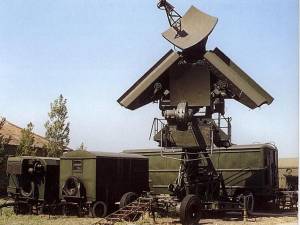Low Blow tracking and missile control radar
Description of the radar set, tactical-technical characteristics

Figure 1: AA-missile system S-125 (© НПО "Алмаз")

Figure 1: AA-missile system S-125 (© НПО "Алмаз")
| Specifications | |
|---|---|
| frequency: | 9 … 9.4 GHz |
| pulse repetition time (PRT): | 288 and 560 µs |
| pulse repetition frequency (PRF): | 1,750 and 3,500 Hz |
| pulsewidth (τ): | 0.26 and 0.5 µs |
| receive time: | |
| dead time: | |
| peak power: | 210 kW |
| average power: | |
| instrumented range: | 40 and 80 km |
| range resolution: | 30 m |
| accuracy: | |
| beamwidth: | 1° |
| hits per scan: | |
| antenna rotation: | |
| MTBCF: | |
| MTTR: | |
Low Blow tracking and missile control radar
Russian designator: S-125 “Newa” (Kabina UNW)
Low Blow is the NATO reporting name given to a family of I-Band radars used with land-based SA-3 “Goa” surface-to-air missiles. The name Low Blow reflects the ability of the radar to guide the missile towards low-flying targets through heavy clutter.
It use pairs of electromechanically scanning (so-called Lewis scanner) antennas mounted orthogonally, but to improve low-angle performance the antennas are mounted at 45 degrees from the horizontal. Both antennas are mounted at a 45 degrees angle in an upside down “V” shape. This change was introduced to reduce ground clutter. The antennas generate sawtooth fan beams like Fan Song. Between these two antennas is a Lobe-On-Receive-Only (LORO) mode antenna. When these antennas acquire a target the system can be switched to the LORO mode, receiving from this central parabolic dish antenna. The target in Low Blow tracking antennas scan in 6 degrees swathes, the beams are about 6 degrees wide in the fan and 1 degree in the scanning direction. Inserted into the top of the inverted “V” is the square parabolic guidance command antenna with a beam with of 12 degrees.
The system is equipped with a high-resolution television camera by default with an 144 mm lens. Its infrared sensitivity allows working at night and at low-light conditions.
More: www.peters-ada.de
Lobe on Receive Only (LORO)
In its acquisition mode the small beamed radar must scan a large location segment. The transmitting antennae (UW-11) emit a few “exploratory” pulses along a direction obtained from the acquisition channels of the Low Blow radar. By the mechanically controlled (Lewis scanner) antennae these pulses are centered in different directions. These exploratory pulses are the acquisition mode of the target tracking radar.
When the pulse is received, it is “cut-off” on the leading edge and only that portion is fed to the radar signal processing. This allows the radar to effectively track on the leading edge of the target. The both polarisation channels of receiving antenna (UW-10) scan their sector for the target return due to these exploratory pulses. As the power centroid is located, the center of the receiving pattern is brought onto the target. The transmitting antennae is then pointing directly at the desired target and only that target is radiated during tracking. This approach allows a very narrow directivity but the angular resolution of the system is still that of the receiving antenna.
